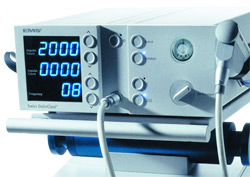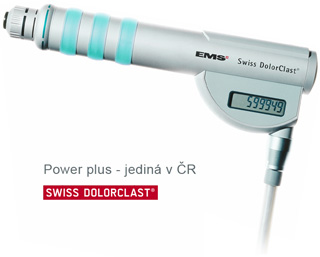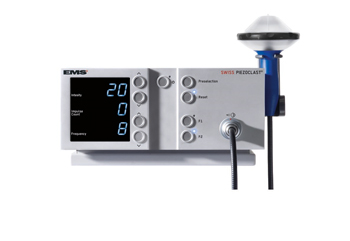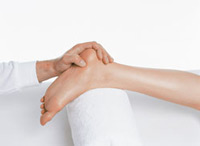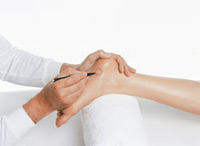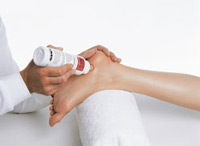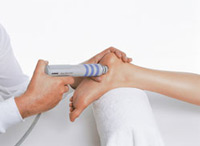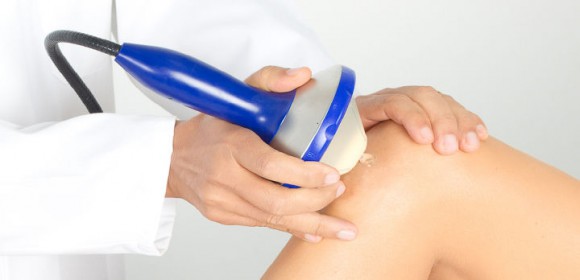What is shock wave therapy?
Shock wave therapy is comprised of the effect of shock waves which are applied to the affected site of the disease using a PowerPlus probe. The device’s generator changes the air wave (5-6 bar) into an acoustic radial wave, which is transferred by the head of the applicator to a tissue depth of approx. 4 cm (up to 15 cm) at the site of the pain. This improves microcirculation and metabolism at the site. The waves enable dissolution of calcified fibroblasts, support production of collagen, reduce tension in the tissue and have an analgetic effect. Simply put, shock waves work on the principle of improving circulation at the given site and regenerating the affected cells. A suitably selected impulse frequency in the range of 1 to 15 Hz can help reduce the duration of rehabilitation; the greatest amount of energy is released from the top of the applicator and its precise targeting eliminates the risk of energy loss outside of the body.
Swiss PiezoClast is a new device on the market that generates piesoelectric focused shock waves. In our clinic, this system is combined with the Swiss DolorClast Classic device for radial shock wave application and together they comprise a modular system known as the Swiss DuoClast. The fundamental element of the applicator head are piesoelectric crystals, which increase their volume by several micrometers through the shock and create a pressure wave in the immediate surrounding area. All of the pressure waves thus meet in one focal point, where their intensity is combined. The application itself is much less painful. Precise targeting in the given tissue positively effects cell formation and cell function, which reduces pain and improves blood circulation in the given area. The device has several detachable gel adapters which make it easy to set the depth penetration.
The doctor’s specific experience and expertise are a prerequisite for achieving these treatment efficacy results and are essential to providing a guarantee of positive results from this innovative method. One of the advantages of our clinic is that all applications during therapy are performed by a single doctor, who is thus the only one capable of continually monitoring the development (or regression) of the disease and subsequently setting the ideal application intervals and dosage.
Ligament pain around minor and major joints throughout the body is typically treated through surgery, orthopaedic and physical therapy with various rates of efficacy, general or local medicaments and/or corticoid injections with local anaesthesia. Low physical therapy efficacy rates typically lead to surgery – often with uncertain results. When compared with these predominant treatment methods, shockwave therapy shows clear advantages. The efficacy of this “new” method is around 95%, which is a wholly unprecedented figure in medicine. This rate has been demonstrated by studies and practical experience in Germany and Switzerland and confirmed by our own practice.
Application
Shock wave therapy is performed on an outpatient basis and does not require much time – each application takes just a few minutes. Typically, several applications are needed over a period of several weeks. The intervals between applications are determined by the doctor based on factors such as the dynamics of the disease development (or according to intermittent assessment of the treatment response). Using the device applicator head, the doctor transmits radial acoustic or focused waves into the affected site of the musculoskeletal system to a tissue depth of up to 15 cm. Contact gel is applied to improve the transmission quality between the head and the treated tissue. The patient feels the transmission of the shock waves to the tissue as a rhythmic tapping “like a light hammer”. If the application is perceived more sensitively by the patient, it is usually tolerable without local anaesthesia.
Benefits
This new method is developing very rapidly, which means that what held a few years ago is no longer valid or has changed. The number of diagnoses and diseases that can be treated with shockwave therapy is increasing very quickly. For most diseases the treatment is causal but for some diseases such as advanced arthritis it relieves pain. Today, this therapy can be used for back pain, rheumatic diseases, knee, shoulder and joint arthrosis and other musculoskeletal diseases, including post-injury conditions and post-operative conditions.

